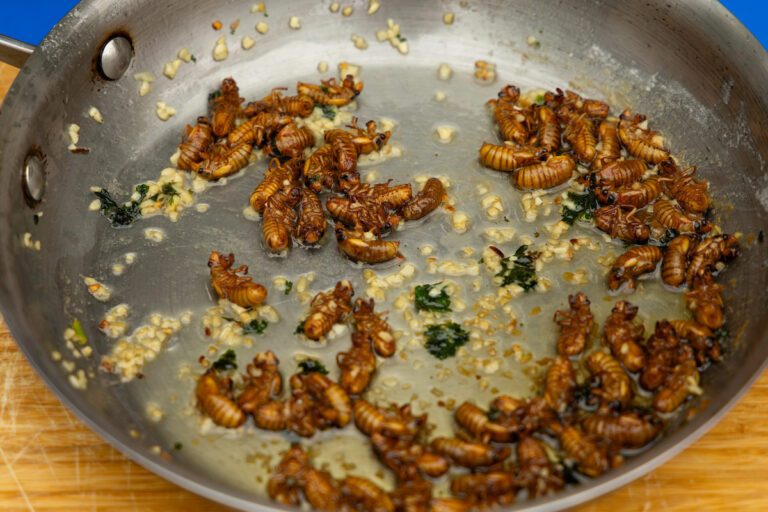Researchers and bug enthusiasts are cooking up cicadas as sweet snacks or pizza toppings this summer. Some hope cicadas will help entomophagy – the practice of eating insects – catch on.
The last several weeks have provided a rare occurrence, as two periodical cicada broods emerged in more than a dozen states.
For the more adventurous — it’s also been a chance to incorporate the insects into food.
“It’s a very regional delicacy because we’re the only place with periodical cicadas in the entire world,” said May Berenbaum, the head of the University of Illinois Department of Entomology.
Eating insects is fairly common in many parts of the world, but generally unpopular in the United States. Yet the cicadas that arrived in the Midwest this spring — projected to be in the trillions — made them hard to ignore, especially for food pioneers.
The 13-year Brood XIX emerged in much of Illinois, Iowa and Missouri, while the 17-year Brood XIII, surfaced in northern Illinois, Iowa and Wisconsin and some areas of Indiana and Michigan.
Cicadas and other insects, like crickets and ants, can be an environmentally-sustainable protein option, according to Berenbaum.
“They have a very manageable carbon footprint and water footprint in general, depending on the species,” Berenbaum said. “Nutritionally, there’s absolutely no reason why we can’t thrive on insect flesh. It’s just that cultural aversions are sometimes hard to overcome.”

Are cicadas the gateway insect?
Joseph Yoon is the chef and owner of Brooklyn Bugs, an advocacy group that promotes the use of insects as food. He describes himself as an “edible insect ambassador” and travels to promote eating insects as a step toward sustainability.
“We’re very happily working towards and seeing a tremendous growth, change and transformation,” he said, “not just in people’s perceptions around edible insects, (but) the acceptance, and also the behavioral change that we’d like to see out of all that as well.”
Cicadas have provided Yoon with a golden opportunity this summer. He visited central Illinois in May to collect cicadas for future cooking. His list of dishes includes cicada kimchee and a chocolate-caramel popcorn, with cicada nymphs filling in as the popcorn.
“One of the big revelations with that is just how meaty the cicadas are as well, particularly the nymphs,” said Yoon, who last encountered cicadas in 2021. “And when you see a cross section of them, they’re just entirely full of meat.”
Horticulture educator Ken Johnson collected the periodical cicadas after they molted and put them in the freezer – what he considers the most humane way to kill the insects. As part of Illinois Extension’s Good Growing podcast, Johnson created three dishes and sampled them with his guests.
His favorite was the pesto pizza.
“If you looked up close, then, yeah, you could see their eyes and everything, which to some people may be a little off putting,” Johnson said. “So maybe just put a little cheese on there, if that bothers you. But it tasted good to me.”

He doesn’t expect cicadas or other insects to replace beef, pork or chicken in western diets, but he thinks they could serve a supplemental role.
“As we’re looking at an increasing population, can insects – probably not cicadas – but can insects play a role in feeding the world?” Johnson asked. “And if eating periodical cicadas are the gateway to getting people a little more comfortable with that, all the better.”
The window for eating cicadas, though, is closing soon, as the periodical cicadas mate, lay eggs and die off.
But another periodical cicada swarm is due to emerge in 2025, when the 17-year Brood XIV will be coming out in parts of Kentucky, Tennessee, Ohio, Virginia, West Virginia and North Carolina.
This story was produced in partnership with Harvest Public Media, a collaboration of public media newsrooms in the Midwest. It reports on food systems, agriculture and rural issues.

